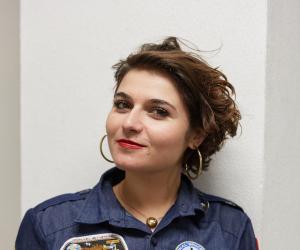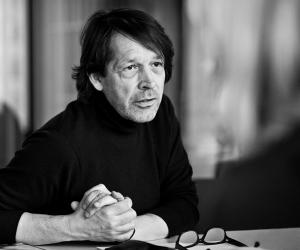“Banks should be on the ground floor!”
It’s a rainy day in Perugia, a typical day to go to work by car. “Car is a mistake, idiot!”, design activist Enzo Mari would tell you. Mari, a very charismatic man with a characteristic white beard.
He walked, looking animated, on the bright stage. “Ford was a utopian, he did cars for people to be able to buy them. But to say that cars and all of these stupid technologies should be part of our future is odious. Computers are a defeat!”
Boom!
This was the scene set by controversial Italian designer Mari. “Service cities should be forbidden, we need to bring back factories in the city, we need to be able to work together. Work is a human state and we need to apprehend this face-to-face, not through software, screens or computers,” he said.
“What would happen if the computer disappears suddenly… well… not much… but if the potatoes do, then here we have a real problem.”
Such a magical moment, to see and hear the grave voice of Mari against Bill Gates, prime ministers, business workers and also against architects. It is like having a reality check, or coming back to the check point. He told us about his experience of Milan, how a mistake was made after the repressive time of fascism, how they all needed to rebuild the city as it was before, while they were all vying for freedom. “Utopia resides in the mythology of Uncle Sam,” he said.
What’s missing is “the monument in the city, they are what used to signal the danger, the sign of the past”. Mari said: “Architects are incapable of being thoughtful, we should ask artists to be involved.”
Nowadays the highest buildings are the ones of banks. These building are the “point of glory for the city”. Mari asked: “How can this be a bank? This is so ironic, utopias in this context can only be silly spectacles of dust and guns.”
Heritage luxury: Past becomes future
Dutch architect, OMA creator and co-founder of Volume, Rem Koolhaas believes in respecting the past, instead of turning it into something beautiful.
In a very impressive one-man show, with the Teatro de Morlacchi packed all the way to the top balconies, Rem Koolhaas’s lecture was one of the highlights of the festival.
He said we are “obsess[ed] by the preservation of space, we want to maintain the tradition, what we end up doing is destroying history by our intent to preserve it”.
In 1790, after the French Revolution, the Commission des monuments was created. This comprised guidelines to preserve a part, or the whole, of existing buildings. By being classified “Historique Monument E”, a building was marked with a set of rules to avoid modifications.
In 1987 the Unesco World Heritage Convention declared that 12% of the world will never be modified. “How ironic is this situation? In a context where all changes so radically everyday, every time, some part of the world will remain forever the same,” said Koolhaas.
This listed cultural heritage also contains story telling, festivals, and processions.
“This heritage is increasing with tourism, it used to be that heritage was seen as being against development but now heritage is development. The past is becoming our future.”
Koolhaas pointed out situations in which this becomes problematic, namely authenticity and restoration. “The Patrimoine Mondial preserves artificially. We will not preserve council houses from the 60s, or places of disaster such as the Chernobyl site, or the twin towers. We will rather prefer turning them into something beautiful and aesthetically interesting.”
This thinking contributed to the other concept presented by Koolhaas, the thinning of a city. Many components are responsible for this thinning. One of them, according to him, is the lack of confrontation between art and architecture. This leads to artificiality and totalitarianism in art. For Koolhaas, the typical example of this is the Turbine Hall at the Tate Modern in London, “a large scale experience of totalitarianism in art”. Thinning and artificial preservation are the two contributions of Koolhaas to the general theme of “Anti-City”.
A new world adventurer’s guide
Berlin-based designer Jerszy Seymour explained how design is the creation of life situations. For him it is a continual workshop and involves collaborations with amateurs, by designing situations for debates on “utopias or starch plastic and scum”.
Seymour built his own living system, his own sensible and colourful typography of design and landscape. “What is the situation zero in design?” he asked in the project “The First Supper”. Here, coming out of a handmade oven, pumpkin soup and jelly dishes were served to more than 120 people on furniture made of wax and starch potato plastic.
This lead him to create the “Salon des amateurs”, a sauna pool inspired by Doctor Strangelove, a gallery in Berlin to organise the Amateurs coalition.
Metaphor of curtains. In-situ constraints. Inclusive architecture. How to produce reality?
These are the few listings of other concepts mentioned yesterday.
Petra Blaisse, director of Inside Outside, explained how we can change urban and architectural contexts by using simple but giant curtains.
French architect Odile Decq presented the new restaurant project she is working on at Opera Garnier, with all the technical issues and conservation constraints of such a protected building.
But for Giancarlo Mazzanti, an Italian architect living in Columbia, it is all about creating architecture for social inclusion. “An architect should be defined by what he does.” Architects should produce structures for humans but also for machines and their “parliament of objects”, he said.
Hans Ulrich Obrist and Stefano Boeri talked about the need for architects “to produce reality by being involved in politics”. Peter Saville, who was recently named artistic director of Manchester, and many other artists moved to a political career. Like Edi Rama, now mayor of the city of Tirana.
We will close today’s report with this extract from Mythology, a book written by Roland Barthes. This could very well summarise the current architectural situation. A certain lack of passion maybe? The need for a city based on intense emotions? Or the desperate attempt to reach utopia?
"We are therefore dealing with a real Human Comedy, where the most socially-inspired nuances of passion (conceit, rightfulness, refined cruelty, a sense of 'paying one's debts') always felicitously find the clearest sign which can receive them, express them, and triumphantly carry them to the confines of the hall... it no longer matters whether the passion is genuine or not. What the public wants is the image of passion, not passion itself.”












